 Image search results - "women" Image search results - "women" |
|
|
|

Omiko shrine maidens. On the previous day during the Sacred Carriage Procession, they performed sacred dances on a truck. お巫女
|
|
|

Miss Nippon
|
|

Here's one reason for the crowd...
|
|

Miss Nippon throw beans, but not very far.
|
|

And another one. Young pretty/cute girls in costume pass out flyers, but end up being street models for amateur photographers who have no girlfriends to shoot.
|
|

Kimono beauties and beans do mix well.
|
|

They are happy to pose...
|
|

Women in kimono is a must on Setsubun day.
|
|

The maid costume is all the rage in Japan, for several years now.
|
|

Minor female idols also on hand to throw beans.
|
|

Santa suit appears in Dec.
|
|

節分会に吉井怜、三津谷葉子、福下恵美が豆まく
|
|

Bikini idols Yoshii Rei, Mitsuya Yoko, and Fukushita Megumi throwing beans on Setsubun
|
|

Each mikoshi is preceded by a row of women carrying lanterns and wands. Also see the video at YouTube
|
|

Bean throwers make speeches.
|
|

Miss Nippon somethings
|
|

Throw the beans farther!
|
|

Procession maidens pose with the giant penis. The giant phallus was then partially hidden by the portable shrine as it is today. But this made the phallus become larger to 2.5 meters, as if to compensate for this partial shielding.
|
|

Fuku wa uchi!!
|
|

Palanquin maidens.
|
|

This mikoshi is being carried by all women, already soaked to the bone. They carry the mikoshi flat on their shoulders. This is called "Hira katsugi," literally "flat carrying."There are four basic methods of carrying a portable shrine. This is the most basic method where they carry it flat on their shoulders. This is called "Hira katsugi," literally "flat carrying."
|
|

Setsubun bean throwing at Takahata Fudoson temple, Hino, Tokyo
|
|

Setsubun bean throwing at Takahata Fudoson temple, Hino, Tokyo
|
|
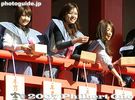
Bikini idols Yoshii Rei, Mitsuya Yoko, and Fukushita Megumi throw beans a second time.
|
|
|
|
|

Maids to greet you
|
|

Maids, the costume rage in Japan for several years already.
|
|

Welcome!
|
|
|
|

Tokyo Anime Center
|
|

Many life-size costumed characters on display.
|
|
|

Tokyo Anime Center, Akihabara
|
|

Big expressive eyes.
|
|

Straight black hair is pretty too.
|
|

Blue ponytails
|
|

Goldilocks?
|
|

Space teen?
|
|
|

School uniform
|
|
|
|

Redhead in school uniform
|
|
|
|

With raised arms, this is one way to carry the mikoshi.
|
|

Anybody who knows the names of these characters are welcome to enlighten me...
|
|

Sakura
|
|

Merry Christmas
|
|
|
|
|
|
|

Pikachu, Astro Boy, Doraemon
|
|

They sing on the street to advertise something, usually a night club where they appear.
|
|

The ever-popular maid outfit.
|
|
|

Maids attract much attention so they are used as living billboards for stores and whatever needs to be advertised in Akihabara.
|
|

Cosplayer teenager posing on the road.
|
|

The problem is that the police patrol the main drag to expel these street performers. It is not allowed. It would be the Japanese police to try and kill Japan's street culture.
|
|

Fukagawa Tekomai geisha make their entrance. 深川手古舞
|
|
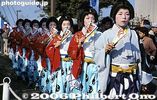
The Fukagawa Tekomai geisha make their way to the stage.
|
|

They chant without instruments.
|
|
|

Street singer in front of JR Akihabara Station's new Central entrance
|
|
|
|

Street singer in front of JR Akihabara Station's new Central entrance. A cute face and miniskirt really help to gather a crowd.
|
|

Each carry a lantern bearing their name.
|
|

Her setup is simple. A portable and battery-powered amplifier connected to a microphone. The amp is on a luggage cart. When the police comes, she can pack up and leave within 5 sec.
|
|

They always carry a flower hat, but I've never seen them wear it.
|
|

These girls usually have a lookout man who watches out for the cops. As soon as he sees one coming, he runs up to her and gives the "Outta here" signal. They're gone before the police can even see them. It's a constant cat and mouse game
|
|
|

She says that it was her first "Street live performance" (rojo raibu).
|
|
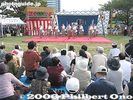
The stage in Kiba Park and spectators.
|
|
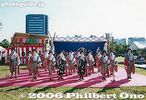
Fukagawa Tekomai Geisha performing at Kiba Park, Koto Ward, Tokyo.
|
|
|
|

Street performer
|
|

Street performer near Yodobashi-Akiba, the largest store in Akihabara.
|
|
|

A miniskirted pair
|
|
|
|
|
|
|
|
|
|
|
|

New Year's, Gifu Station
|
|

Coming-of-Age Day, Himeji
|
|

Kimono women going to a convenience store, Ako, Hyogo
|
|

Cigarette break on Coming-of-Age Day. Yes, they can now smoke legally.Ako, Hyogo Pref.
|
|

Reception table backed by a board listing various corporate sponsors. I attended the final show on Oct. 29, 2008 at 3 pm.
|
|

Stairway to the hall.
|
|

A side attraction was a tea session (ocha-seki) performed and served by two geisha (or hangyoku). It cost 700 yen for tea and sweets. お茶席
|
|

Hall lobby (Get that trash bin outta there.)
|
|

The 2nd floor had a booth selling Asakusa geisha souvenirs. The dance program was 1,000 yen.
|
|

A hand towel with the names of all the current Asakusa geisha was selling for 1,500 yen. They also had T-shirts.
|
|

Name cards of all the geisha were sold for 100 yen apiece.
|
|

Name cards of all 49 Asakusa geisha.
|
|

The dance consisted of four numbers. The first one was called Sara Sanban-so (晒三番叟) which was first performed in Edo in Nov. 1755. 宝暦5年
|
|
|
|
|
|
|
|
|
|

There were only four dancers, but they went through several costume changes onstage.
|
|
|
|
|
|
|
|
|
|
|
|
|
|
|
|
|

Waving these white streamers created a dazzling visual effect. It must have been either the wind or river.
|
|
|
|

For the second number, there was a little stage for the musicians and singers on the right of the stage.
|
|
|

The second number was called Matsuri (Festival). It featured these three young village girls and two geisha dancers. 藤間流 まつり
|
|
|
|
|
|
|
|
|
|
|
|
|
|
|
|
|
|
|
|
|
|
|

The third number was called 三枚続花の姿絵 and consisted of three parts. The first part was called 星月夜 which means "Night of Stars and Moon."
|
|
|

These six geisha dressed as young maidens make their first-time appearance in the Asakusa Odori.
|
|
|
|
|
|

With a dark background, the geisha seemed to glow in the dark.
|
|
|
|
|
|
|
|
|
|
|
|

Sank into the stage to disappear.
|
|

The second part of 三枚続花の姿絵 was called Hagi no Hanazuma 萩の花妻 which means Bush Clover Flower Lady.
|
|

A more mature woman appears for this part set in autumn.
|
|
|

She left the stage this way.
|
|

The third part of 三枚続花の姿絵 was called Hana no Shojo 花の猩々 which means Flowery Heavy Drinker. This play comes from a Noh play.
|
|

The play is set during the cherry blossom season.
|
|
|

Three red-haired lions.
|
|
|
|
|
|
|
|
|
|

Drinking sake
|
|
|
|
|
|
|
|

The three red lions were nice, but they didn't swing their hair round and round like in kabuki.
|
|
|
|

On the hanamichi
|
|
|
|

Then there was a 20-min. intermission which featured a comedic trio.
|
|

I took the intermission time to photograph an Asakusa geisha.
|
|

Lobby
|
|

The fourth and final number was the Finale called 江戸の心浅茅の賑い which consisted of six parts. They performed their zashiki dances.
|
|

The Finale's first part was called Namiki Komagata-Koi no Asakusa 並木駒形 恋の浅草
|
|
|
|

Dancing on the hanamichi
|
|
|
|
|
|
|

The third part of the Finale. 五万石
|
|

Fourth part of the Finale. 笠森おせん
|
|
|

Last part of the Finale called Asakusa Meibutsu-Sawagi when they all came out dancing on the stage and hanamichi. 浅草名物 さわぎ
|
|
|
|
|
|
|
|
|
|

Then they all sat and started to bow. It was really an outstanding performance.
|
|

Asakusa geisha bowing to the audience in three directions. Bravo!
|
|

Since this was the final show (Oct. 29, 2008 at 3 pm), they all appeared on the stage with the organizers and said a few words.
|
|

Asakusa Odori organizer speaks to thank the audience. He said that people looked forward to seeing the next Asakusa Odori next year, but he said, "There won't be one next year."
|
|
|
|

At the end, we clapped in celebration. The show was 2.5 hours long, including a 10-min. and 20-min. intermission.
|
|

Asakusa hangyoku (apprentice geisha in Tokyo). 半玉 千福
|
|

Asakusa hangyoku (apprentice geisha in Tokyo). 半玉 こず江
|
|
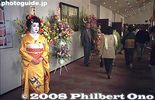
I also saw the 22nd Asakusa Odori held in April 2001 at the Asakusa Kokaido. The lobby had two hangoyku greeting the audience.
|
|

Asakusa hangyoku (apprentice geisha in Tokyo) named Ichigo posing in April 2001. 半玉
|
|

22nd Asakusa Odori, April 2001.
|
|
|

I still prefer real, human mascots of the feminine kind...
|
|

Finally at 7:30 pm, the main event called Dancing Soda Night started along Route 13 and Ekimae-dori.
|
|
|
|
|
|
|
|

School girls
|
|
|
|
|
|

Many of the dance groups were from dance studios or schools.
|
|
|
|

Fukushima Waraji Matsuri
|
|

Fukushima Waraji Matsuri
|
|

Eisa group from Okinawa
|
|
|
|

At the intersection. Notice the giant waraji straw sandal.
|
|

Some fireworks
|
|
|

Awards ceremony. The festival ended at about 9:30 pm.
|
|

Out of all the geisha that have appeared on postcards, this ever-smiling geisha was unsurpassed in popularity. Her smiling visage appeared in 40 to 50 different poses in photographs and postcards made in Yokohama from the 1890s.
|
|
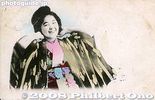
Her affable and infectious smile made her stand out during a time when most people posing for a photograph did not smile.
|
|
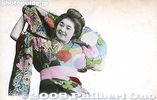
Her name has been a mystery, but I have come across hard evidence that she was a geisha named "Tokimatsu." But I will forever call her the "Laughing Geisha."
|
|
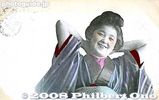
A saucy little Geisha. The pose is good.
|
|

Laughing Geisha with low neck. She's almost semi-nude. It is probably her sexiest pose of all. A great summertime card and one of my favorites. Hand-colored and postmarked Feb. 25, 1908 in Yokohama. The actual card is more yellowed.
|
|

Laughing Geisha with cowboy hat & cigar. This must be the most humorous pose she created. Those tourists must've gotten a big kick when they saw this card. A geisha from the wild, wild West. Even today, it elicits an affectionate laugh. One of my
|
|
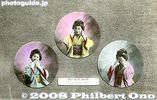
See, hear, nor speak no evil.
|
|
| 2034 files on 9 page(s) |
1 |
 |
 |
 |
 |
|